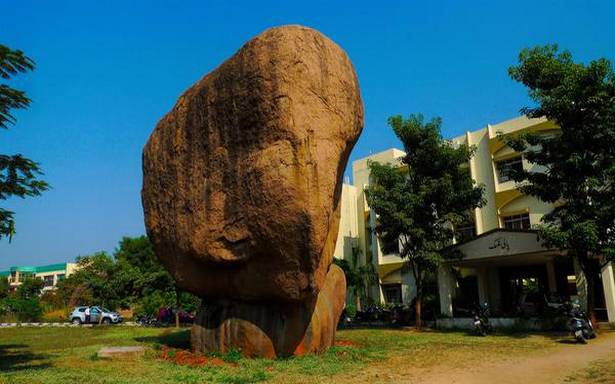ART NEWS
In Hyderabad, rocks that resemble an elephant and a one-eyed gentleman
A virtual photography exhibition to mark the 25th anniversary of Society to Save Rocks presents a ringside view of the rocks of Telangana and the Deccan
In a photograph taken by Sathya Prakash, a member of the Hyderabad-based Society to Save Rocks, the HITEC City stands tall. The landmark constructed 22 years ago marked the beginning of the IT boom and the formation of Cyberabad. Also warranting attention in the photograph is a majestic rock. “This boulder has been around for 2,500 million years, dwarfing the two-decade-old HITEC City and the 400-year-plus city of Hyderabad,” Sathya Prakash points out, in his presentation during the inauguration of the virtual photo exhibition Rocks Matter’. Rocks Matter commemorates the 25th anniversary of Society to Save Rocks, in collaboration with Goethe Zentrum Hyderabad. Curated by photographers and Society members Sangeeta Varma and Ashok Kumar Vootla, the exhibition features 73 images by 13 photographers in seven categories — unique rock formations, recreation and rocks, rocks and water bodies, flora and fauna in rocks, rocks and religious places, destruction of rocks and rocks integrated into living spaces.The ‘unique rock formation’ section features rocks that are popularly known as well as hidden gems. Many Hyderabadis would be familiar with the ‘mushroom rock’ at the University of Hyderabad. There are others as well, resembling an elephant, a tortoise, rabbit ears, a sleeping Godzilla, and a human skull.Ashok Vootla trains his lens on a rock in L B Nagar, Hyderabad, which resembles a ‘one-eyed gentleman’. Amita Talwar captures a rock formation resembling the slippery slide, and Sangeeta Varma documents the ‘five tile rock’ at Ghar-e-Mubarak near Taramati Baradari.
The ‘recreation on rocks’ segment offers a peek into rock tourism, with scope for rock climbing, trekking, rappelling and bouldering in the outskirts of Hyderabad and in Medak and Warangal. Some of the caves in Warangal and Medak are tourist magnets for their vivid paintings of animals and other figurines that date back to the Paleolithic age.‘Rocks and water bodies’ frames rocks adjacent to lakes and new urban constructions in areas around Durgam Cheruvu, Gachibowli and Kokapet. However, these burgeoning regions have also witnessed rampant destruction of rocks to make way for high rises. The exhibition throws light on this dismal scenario, and contrasts it with examples of how rocks can be integrated into living spaces — houses and commercial establishments that work their architecture around massive boulders. Naubat Pahad, Fakhruddingutta, Bear’s Nose in Madhapur, the Trident hotel are a few examples.As for the flora and fauna in the vicinity of rocks, all it takes is a closer look at the shrubs, weeds, birds and insects that inhabit the rocky ecosystem. Asif Husain Arastu’s photograph is a rare capture of an owl amid rocks, and Kobita Dass Kolli photographs the Keeled Indian Mabuya and Broad headed and fan throated lizard, among other insects and birds in the vicinity of Gandipet lake.What’s a rocky terrain without religious importance? There is no dearth of dargahs and temples on rocks. The Moula Ali Dargah and Mallikarjun temple in Jubilee Hills, Hyderabad, are among the many. The exhibition includes a few images of the majestic rocks in Hampi, Karnataka, as part of the Deccan plateau focus. The Malyavanta temple in Hampi, framed against the sun, is a sight to behold in the image captured by Irfan Quader.The Rocks Matter exhibition is among the events lined up by Society to Save Rocks for its silver jubilee year. A virtual quiz, community outreach to schools, and an overnight trip to a rocky getaway are in the pipeline. The organisation plans to continue to felicitate organisations and individuals who preserve rocks in their premises.The Society to Save Rocks has been proactively conducting rock walks and adventure rockathons to enthuse more people to know about rock formations. However, now and then they confront the question ‘why are you so keen on saving rocks? Why not take up social welfare schemes for people?’ The answers lie in the long-forgotten geography lessons of rocks being an essential part of the ecosystem, influencing the water table and supporting flora and fauna.(Rocks Matter can be viewed on https://tinyurl.com/rocksmatter till July 24)











